How to fill a closed heating system easily and without errors?
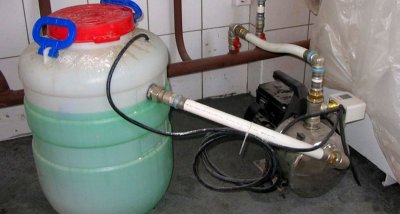
Closed heating system has no connection with the atmosphere, which partially increases the pressure.
This is due to protection from environmental conditions and weather changes outside.
Filling a closed heating system with coolant has its own characteristics.
Features of filling a closed-type heating system
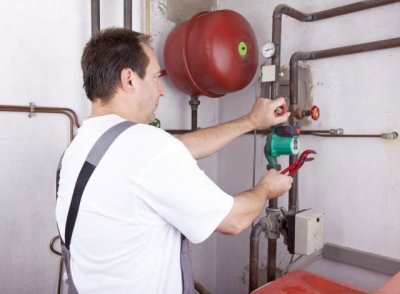
To perform the work you need pump and expansion tank. It is recommended to do this together. Task first - fill the circuit with water while the second one controls the air release.
If you have to do everything in alone, it is enough to turn on a weak pressure. The valve for gas discharge should be at the top of the pipeline, at a distance from the boiler.
Before starting, place a container under the place where the liquid is leaking to collect it.
A tap is installed to remove water down. Not far from it, near the boiler, a feed pipe is mounted. For filling, a hose is used, which is placed in the water supply or connected to the pump. A successful process is facilitated by high pressure. The system is filled when liquid appears from the drain valve. Then the air is released and the pressure is checked. If necessary, the procedure is repeated.
In a two-circuit system the process is simpler. For filling use feed system, if any. It will automatically balance, remove gas and select the specified pressure. If it is not available, you will need to connect the water supply to the boiler with a hose and fill it through the latter. In this case, you will have to manually clean the circuit from air.

If the boiler gas, it will have to be removed from him front cover. There is a pump for pumping. The device is turned on, warming up the coolant.
The liquid is mixed with the gas that needs to be removed: to do this, the valve inside the device is slightly opened with a screwdriver. When water appears from it, the valve is closed.
The procedure is repeated 3-5 times with an interval of 2-3 minutes. If the boiler stops bubbling, the pressure is checked.
Having finished filling the closed system, they proceed to inspecting the integrity of the pipes. After that, they do debugging and hydraulic testing.
Types of coolants
There are several types, mainly liquids, but also occur gaseous. Most often used the following two substances.
Water
It is a standard pipeline filler. It tolerates heat well and does not cause chemical reactions, except for oxidation of metals. As the circuit is used, it partially fills scale, formed as the liquid cools.
Important! When using this substance, it is sufficient to carry out annual cleaning the system from solid deposits.
Antifreeze
Antifreeze is used in systems that periodically turn off, especially in the cold season. This is also useful in northern regions. When cooling, the pipes will not burst, which happens with water. For pouring antifreeze, it is recommended to create a system with small diameter contour, and install radiators panelThis helps to save on liquid consumption.

Photo 1. Antifreeze model ECO-30 on propylene glycol with carboxylate additives, weight - 10 kg, manufacturer - "Thermagent".
In addition, it is much more difficult to fill: antifreeze cannot be poured directly through a hose or through a tank (in a closed system).
The bay is being carried out in one of two ways:
- From below using a pump. It creates pressure, which causes the antifreeze to circulate. This requires a special mechanism that can act on liquids other than water.
- Through the check valve. It is connected to the container, placing it as high as possible. This helps to reduce the pressure. After filling, the remains are drained.
Preparatory work
They are performed regardless of the equipment condition.
Hydraulic test
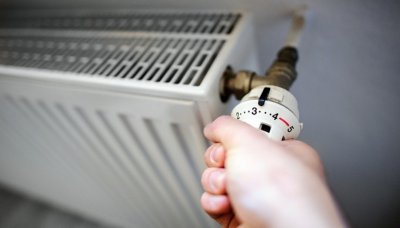
Both old and new pipes need to be flushed and tested:
-
With the help of water harness cleaned from process waste, scale. With the addition of chemicals, it is possible to remove scale and rust.
If the operating rules are followed (the coolant is not drained in summer), this procedure is carried out with a break of two years.
- Testing are performed with air at high pressure. For pressure testing, the working indicator multiply by 1.25 (The value varies depending on the material and volume of water). The pressure may drop during the entire period of operation. no more than 1%.
Troubleshooting
During hydraulic testing, the system is inspected for the presence of cracks and crevices, leaks. After this, you need to check the functionality of the equipment: pump, expansion tank, boiler, etc.
Reinforcement overlap
After completing the inspection, it is necessary to tighten everything valves, leading to the draining of liquid from the radiators, and also to block air valves.
How to fill the system correctly
Exists two fundamentally different ways water flood.
Above
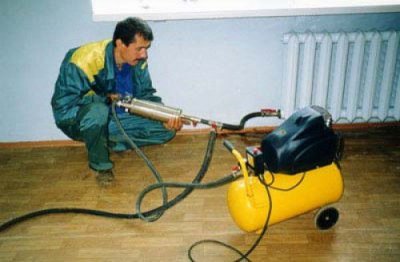
It is carried out with the help of circulation pump. It is advisable to use electric, especially in systems with a pressure drop. heights from 10 meters.
If there is only a manual device, filling can be done from the top point using a nipple that is connected to the air valve.
Liquid is coming in by gravity. The drain valve should be open at the bottom. It is closed as soon as water appears. This helps to create static pressure equal to the height of the circuit divided at 10 atm.
Next, you need to increase the amount of liquid to the working value. nipple connect the hose using a ball valve. On the other side, attach an adapter to the pump with a pressure gauge. Fill the hose with water with the valve on the pipe closed. Then it is transferred to the circuit, creating an air flow from the pump. Procedure repeat 3-5 times. This must be done carefully so that gas does not enter the pipeline. Otherwise, the system will have to be cleaned.
From below
For the procedure you will need a container with a volume of not less than 200 liters (more, depending on the system). A pump is placed in it, creating the necessary pressure.
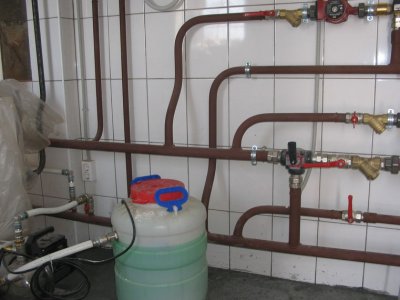
The latter is calculated based on the pressure head: the value in meters divide by 10 and get the number in atmospheres.
The barrel is pre-filled with water. The level should be higher branch pipeto avoid air getting in. As you pump, add liquid.
When filling with antifreeze, use a small container so as not to contaminate the hose and pump body. Its amount must be replenished more often, periodically stopping the process.
Filling is performed when open air ducts. The last ones are Mayevsky taps, placed on the radiators. Objects for collecting liquid are placed under them. When it starts flowing, the valves are closed.
Pressure control is carried out by pressure gauge. If the indicator exceeds the static one (it is taken equal to the length of the pressure in the circuit, divided by 10), water continues to be poured into the system until the required volume is reached.
After finishing the process, the pump is switched off. Then the air valves are uncorked. This is necessary to remove gas from the system. In such a case, the pressure will drop, so it will be necessary to add liquid.
Attention! Finally, you should inspect the harness for presence cracks and leaks.
Features of filling in a private house
The process is not fundamentally different from what happens in an apartment building. You can do it yourself, but it is better to invite specialist.
The required volume of coolant is significantly smaller. The filling is performed in one of two ways, presented above. The choice lies with the design of the harness.
Useful video
Check out this video that shows you how to properly fill your home's heating system.
The price of error
Please remember that incorrect filling will result in unstable operation of the entire system. To prevent this, you should call a water supply specialist.






